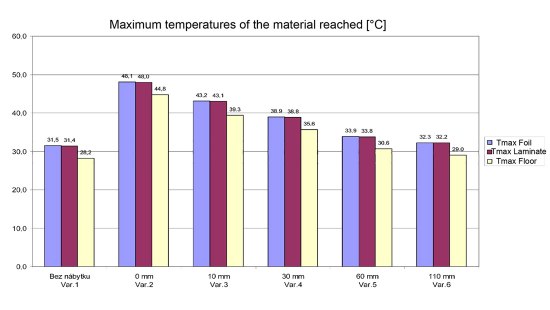Results of measurements – the covering of Ecofilm floor heating which has been installed under a laminate floor

Everyone is certainly familiar with the fact that, from time to time, it is necessary to change the arrangement of furniture within an interior space or replace old furniture with new items. This shouldn't normally cause any problems – but then you realize that the floor is heated with Ecofilm heating foil and that you read in the instructions that the floor mustn't be covered. If a thermostat with a floor probe was used, you may find the sensor was installed exactly on the other side of the room from where you need it to be, in the place where you need to put your new furniture or equipment. This situation occurs very often and is the subject of frequent customer enquiries. We will try to answer these questions in the following text.
For our tests, we set off in two directions – the first being a computer simulation and the second a practical test in the Fenix test-room, the aim of which was to check the results of the computer simulation. The structure of the floor sample was the same both for the computer simulation and for our test (in layers from below):
- 60 mm STYRODUR
- 22 mm chipboard
- 6 mm EXTRUPOR
- 0,4 mm ECOFILM F 1008 heating foil
- 0,25 mm PE foil
- 7,5 mm laminate floor
The air temperature in the room was set at 21 °C. The computer simulation was created by an authorized expert in the field of civil engineering, Doc. Ing. Miloš Kalousek Ph.D., who is also a lecturer at the Brno University of Technology. He evaluated the temperature of the heating foil, the temperature of the bottom part of the laminate board and the temperature of the surface of the laminate for the following cases: complete covering by a cupboard with a level plinth with ground dimensions of 400 × 800 mm (Version 2), then with an air gap of 10; 30; 60; 110 mm – on legs (Versions 3–6), and also for a free, uncovered floor surface (Version 1). Maximum surface temperatures after stabilization (after 23 days):
| Surfacetemperatures (°C) | Var. 1 | Var. 2 | Var. 3 | Var. 4 | Var. 5 | Var. 6 |
| without furniture |
with furniture, the base being at the folowing height above the floor: | |||||
| 0 mm | 10 mm | 30 mm | 60 mm | 110 mm | ||
| Tmax. foil | 31,5 | 48,1 | 43,2 | 39,8 | 33,9 | 32,3 |
| Tmax. laminate | 31,4 | 48,0 | 43,1 | 38,8 | 33,8 | 32,2 |
| Tmax. floor | 28,2 | 44,5 | 39,3 | 35,6 | 30,6 | 39,0 |
The result is a stabilized temperature which is not limited by any element (thermostat etc.), and this temperature stabilization was achieved by the consistent conveyance into the room of heat with a stabilized temperature of 21 °C. It is obvious from the table and the graph that the temperatures of the heating foil and the temperatures of the bottom layer of the laminate board are almost identical, and so no distinction will need to be made during further testing. It is also visible that the temperature gradient between the bottom layer of the laminate board and the surface of the laminate is 3 °C on average. The most important discovery is that for furniture on 60 mm and higher legs, the measured temperatures closely approximate the values for free, uncovered floor. Furthermore, a very positive discovery is that the heating foil, which must not exceed a temperature of 80 °C on a long-term basis during operation, reached a temperature of only 48.1 °C even when covered fully. The results for the temperatures of the bottom and top side of the laminate board seem somewhat worse, as they reached 48 °C and 44.8 °C when covered fully, whereas the producers quote a maximum of 35–40 °C as long-term load. It needs to be pointed out, though, that the long-term temperature load on laminate flooring is about 50 °C when lit by the Sun through a roof window and no problems are usually observed (such as loss of gloss, hue or the opening of joints).
The practical test in the Fenix test-room was carried out with the same parameters as in the computer simulation. The only difference was in the gaps between the cupboards and the surface of the laminate floor, which were adjusted to 20; 40; 60 and 80 mm.
| Ambient temperature 21 °C | Free surface | Gap 80 mm |
Gap 60 mm |
Gap 40 mm |
Gap 20 mm |
Coverage by plinth |
| Temperature of the foil | 37 | 38 | 39 | 40 | 43 | 50 |
| Temperature of the floor | 33 | 34 | 34 | 35 | 37 | 46 |
Again, the measurements confirmed the fact that furniture on legs which are 60 mm high or more has results which closely approximate the results for free, uncovered floor. The temperature gradient ranged between 4–5 °C, which was because the sensor reading the temperature of the foil was placed under the foil and it partially recorded the temperature of the base as well (the diameter of the sensor is 3 mm). Also, when the floor was fully covered, the temperature of the foil reached only 50 °C (the limit being 80 °C).
We compared the computer simulation and our measurements in a graph and discovered that the temperatures obtained from the practical measurements are just slightly higher. However, it is a positive sign that the development of temperatures using both methods is similar – they rise concurrently.
Green – probe on the foil; red – probe on the laminate floor; turquoise – the probe taking the temperature on the underside of the cupboard (with its base raised by 80 mm); dark blue – the probe taking the temperature of the area.
The last graph shows a common situation in households. The Ecofilm F1008 heating foil is connected with a floor probe via a thermostat. A temperature of 27 °C is set on the thermostat for the floor probe (this temperature is a hygienic maximum for rooms inhabited on a long-term basis), the ambient temperature is maintained at 21 °C using an air-conditioning unit (if it were monitored by a room thermostat, the result could only be better). The cupboard with its plinth was placed away from the sensor of the thermostat in such a way that the sensor's performance wasn't influenced by being covered. The resulting graph shows that in the covered area, the temperature didn't exceed 31 °C on the heating foil and 30 °C on the surface of the laminate floor. This discovery is the most important of all. The rule is upheld that when a thermostat with a floor probe is used with a suitably set temperature, the floor must not overheat even if it is fully covered by common household objects with an area of up to 1 m². The use of objects on legs which are higher than 60 mm is shown not to cause any additional heating load on the floor, as the floor behaves like a non-covered surface.






